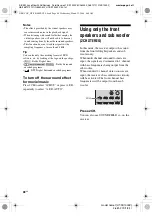
31
GB
E:\SEM_Janet\Year2006\Revision_Data\Revision1_SS1000P\JC060000_2681272121SS1000P_
GB\2681272121\GB04AMP_HT-SS1000P-CEL.fm
masterpage: Right
Am
plifie
r O
p
erati
ons
model name1[HT-SS1000P]
2-681-272-
12
(1)
Adjusting the level
(LEVEL menu)
You can use the LEVEL menu to adjust the
balance and level of each speaker. These
settings are applied to all sound fields.
Select “1-LEVEL” in the amplifier menus. For
details on adjusting the parameters, see
“Navigating through menus” (page 28) and
“Overview of the menus” (page 29).
LEVEL menu parameters
x
T. TONE (Test tone)
Lets you adjust the speaker levels and balance
while listening to the test tone from your
listening position. For details, see “7:
Adjusting the speaker levels and balance
(TEST TONE)” (page 23).
x
FRT BAL (Front speaker
balance)
Lets you adjust the balance between front left
and right speakers.
x
CNT LVL (Center speaker level)
x
SL LVL (Surround left speaker
level)
x
SR LVL (Surround right speaker
level)
x
SW LVL (Sub woofer level)
x
D. RANGE (Dynamic range
compressor)
Lets you compress the dynamic range of the
sound track. This may be useful when you
want to watch movies at low volumes late at
night. Dynamic range compression is possible
with Dolby Digital sources only.
• COMP. OFF
The dynamic range is not compressed.
• COMP. STD
The dynamic range is compressed as
intended by the recording engineer.
• COMP. MAX
The dynamic range is compressed
dramatically.
Tip
Dynamic range compressor lets you compress the
dynamic range of the soundtrack based on the
dynamic range information included in the Dolby
Digital signal.
“COMP. STD” is the standard setting, but it only
enacts light compression. Therefore, we recommend
using the “COMP. MAX” setting. This greatly
compresses the dynamic range and lets you view
movies late at night at low volumes. Unlike analog
limiters, the levels are predetermined and provide a
very natural compression.
GB01COV_HT-SS1000P-CEL.book Page 31 Wednesday, March 22, 2006 8:44 AM
















































